A Fine Addition to any SF Library: Isaac Asimov’s Wonderful Worlds of Science Fiction, edited by Isaac Asimov, Martin H. Greenberg, and Charles G. Waugh
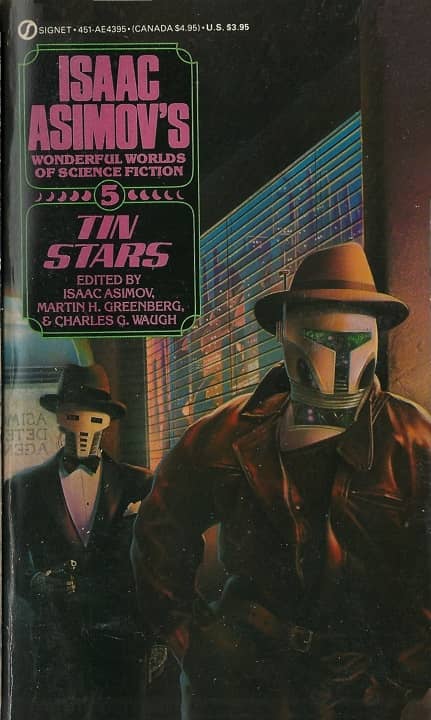 |
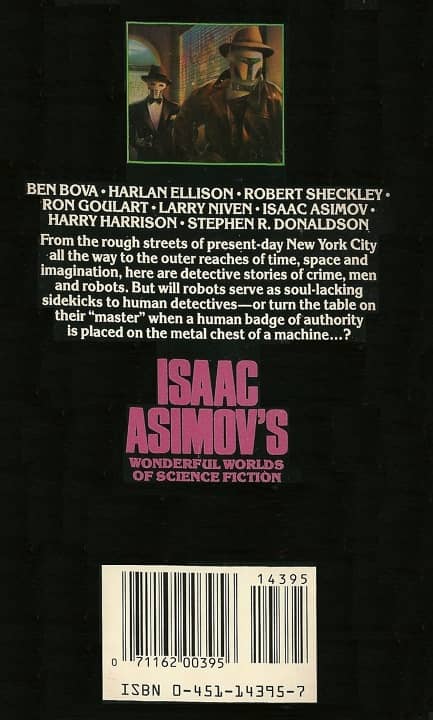 |
Tin Stars (Signet, 1986), volume 5 of Isaac Asimov’s Wonderful Worlds of Science Fiction. Cover by JAV
Isaac Asimov published more than 500 books in his lifetime. Now Asimov was amazingly productive — averaging around 1,700 words published per day over the last two decades of his life — but no one is that prolific. In later years he became a proficient book packager, working with editors like Charles G. Waugh and especially Martin H. Greenberg to churn out dozens and dozens of science fiction anthologies in which he contributed little more than an introduction and perhaps some editorial guidance.
If this sounds dismissive, oh my friends, it is not meant to be. Asimov was interested in a great many things, but one of his earliest and most enduring passions was short fiction. It was his love for early science fiction pulps that set him firmly on the path towards being a successful SF writer by his later teens, and in his later years he became one of the staunchest champions of the science fiction short story — and in particular those stories and authors that, by the 70s and 80s, were in growing danger of being forgotten. Between 1979 and his death in 1992 he put his name (and the considerable selling power behind it) on numerous SF anthologies and long-running anthology series edited with Greenberg and Waugh, including The Great SF Stories (25 volumes, 1979-92), The Mammoth Book series (6 books, 1988-93), Isaac Asimov’s Magical Worlds of Fantasy (12 books, 1983-91), and others. I don’t know if it was ever made explicit, but it seemed pretty clear that Waugh made the selections, Greenberg handled the rights paperwork, and Asimov was sort of a godfather over the whole process. In any case, the success of these books helped inspire other reprint anthologies, and for many decades life was good for classic science fiction lovers.
Those days, of course, are long over, and mass market reprint genre anthologies are scare as hens teeth today. But when times are tough, the tough get creative, and so I’ve been on the hunt for older science fiction anthologies I may have overlooked all those years ago. That’s how I rediscovered Isaac Asimov’s Wonderful Worlds of Science Fiction — and it is a delight.
Like many of his other popular series it was edited with Greenberg and Waugh, and included 10 volumes published between 1983-90. Each had a different theme: Intergalactic Empires, Space Shuttles, Monsters, Invasions, and so forth. They were generously sized (300-400 pages) and came packed with wonderful stories selected by an editor with a keen eye. These books have never been reprinted, but they’re not hard to find. In fact I recently bought a set of five in nearly brand new condition for significantly less than original cover price.
[Click the images for wonderful-sized versions.]
The other four volumes in the lot. Purchased for $12.50 on eBay.
I bought all five (The Science Fictional Olympics, Supermen, Comets, Tin Stars, and Space Shuttles) on eBay for for $12.50.
They all have their charms, but for me the clear favorite is Tin Stars, which collects “detective stories of crime, men and robots.” No small part of its considerable charm comes from the stellar cover by JAV, featuring two hard-boiled robots with attitude, but it also contains some terrific fiction.
Here’s the inside cover flap.
And here’s a snippet from Asimov’s 4-page intro.
I thought at once of my own “Mirror Image,” which appeared in the May 1972 Analog. It was the only short story about Baley and Daneel that I ever wrote… although the story had appeared in two of my own short story collections, it has never been anthologized…
Immediately after my story, by the way, we have placed “Brillo” by Harlan Ellison and Ben Bova. There is a distant connection here, for Harlan sued some television people for rejecting his television script based on “Brillo” and for then running a television program that, to Harlan’s eyes, seemed indistinguishable from his script. He sued, and the television people advanced the astonishing defense that Harlan had no grounds for the suit because he himself had borrowed the story from The Caves of Steel…. I gladly bore formal witness that “Brillo” had a human-robot detective team but was otherwise in no way similar to my novel, and Harlan won his case (and a large sum in damages).
We start the anthology, however, with “Into the Shop” by Ron Goulart, which, in my opinion, is the best short story about a human-robot detective team that has yet been written. It’s got one of those terrific last sentences…
There is “Examination Day” by Henry Slesar, which I had to read three times before I saw the crucial role of a machine and was able to agree with Charles that it belonged in the anthology. (The writing was so smooth and concise that I slid right over that point in my first two readings.)
Then there is “The Fastest Draw” by Larry Eisenberg, a particularly ingenious story, and Edward Wellen’s “Finger of Fate,” in which there is only one detective, no time, and which is a private-eye story to end all private-eye stories…
One word about the title of the anthology. Ben and Harlan called their story “Brillo” because it was about a robot detective, which could be referred to as “metal fuzz,” and what is Brillo but — oh, you get the point, I see.
Well, in “tin star,” the “tin” refers to a robot and the “star” refers to a sheriff. Oh, you get that, too? If it weren’t for the play on words, I would have preferred to call the anthology Robots in Judgment.
Part of Asimov’s introduction to Tin Stars
Tin Stars also contains a Known Space novelette by Larry Niven, a story set in Christopher Anvil’s Federation of Humanity popular milieu, a novella by Stephen R. Donaldson, an original story by Donald Wismer, and a pair of tales by Harry Harrison. Here’s the complete Table of Contents.
Introduction by Isaac Asimov
“Into the Shop” by Ron Goulart (The Magazine of Fantasy and Science Fiction, April 1964)
“Cloak of Anarchy” by Larry Niven (Analog Science Fiction/Science Fact, March 1972)
“The King’s Legions” by Christopher Anvil (Analog Science Fiction -> Science Fact, September 1967)
“Finger of Fate” by Edward Wellen (The Magazine of Fantasy & Science Fiction, June 1980)
“Arm of the Law” by Harry Harrison (Fantastic Universe, August 1958)
“Voiceover” by Edward Wellen (Sherlock Holmes Through Time and Space, 1984)
“The Fastest Draw” by Larry Eisenberg (Amazing Stories, October 1963)
“Mirror Image” by Isaac Asimov (Analog Science Fiction/Science Fact, May 1972)
“Brillo” by Ben Bova and Harlan Ellison (Analog Science Fiction/Science Fact, August 1970)
“The Powers of Observation” by Harry Harrison (Analog Science Fiction -> Science Fact, September 1968)
“Faithfully Yours” by Lou Tabakow (Astounding Science Fiction, December 1955)
“Safe Harbor” by Donald Wismer (original, 1985)
“Examination Day” by Henry Slesar (Playboy, February 1958)
“The Cruel Equations” by Robert Sheckley (Can You Feel Anything When I Do This?, 1971)
“Animal Lover” by Stephen R. Donaldson (Stellar #4: Science-Fiction Stories, 1978)
Here’s the back covers to the four other volumes.
Back covers to The Science Fictional Olympics, Supermen, Comets, Tin Stars, and Space Shuttles
Altogether there were ten volumes, and they make an attractive addition to any science fiction library. Mine is sorely lacking several in the series, but here’s a handsome set of all ten I found online shared by Imgur user aflegeal8.
All ten volumes in the series
Here’s all ten volumes. All were published as paperback originals by Signet. They have never been reprinted.
1 Intergalactic Empires (1983)
2 The Science Fictional Olympics (1984)
3 Supermen (1984)
4 Comets (1986)
5 Tin Stars (1986)
6 Neanderthals (1987)
7 Space Shuttles (1987)
8 Monsters (1988)
9 Robots (1989)
10 Invasions (1990)
Tin Stars was published by Signet in July 1986. It is 352 pages, priced at $3.95 in paperback. The marvelous cover is by JAV. The book has never been reprinted, and there is no digital edition.
See all our coverage of the best vintage SF and fantasy books here.
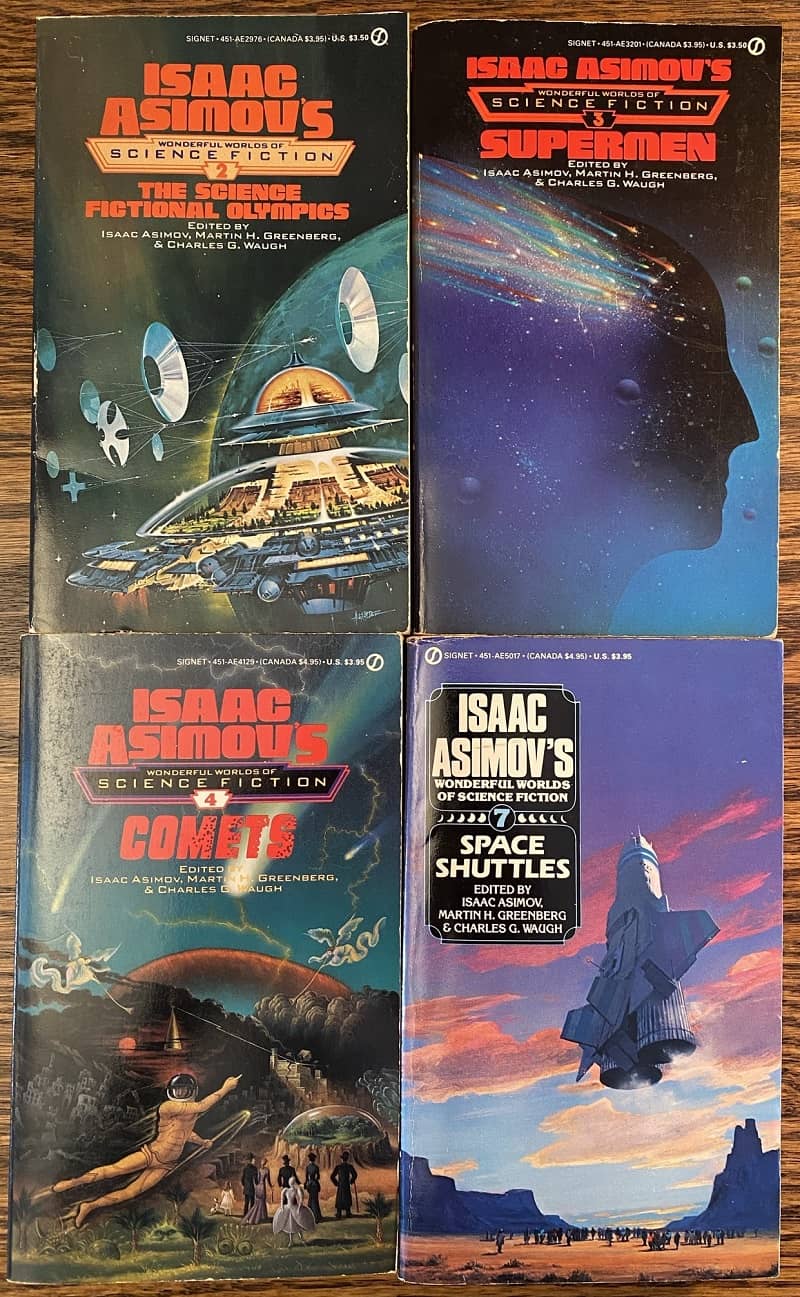
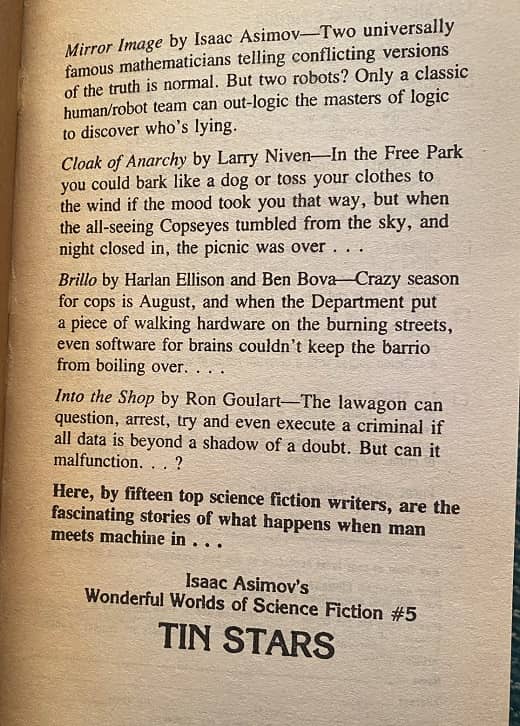
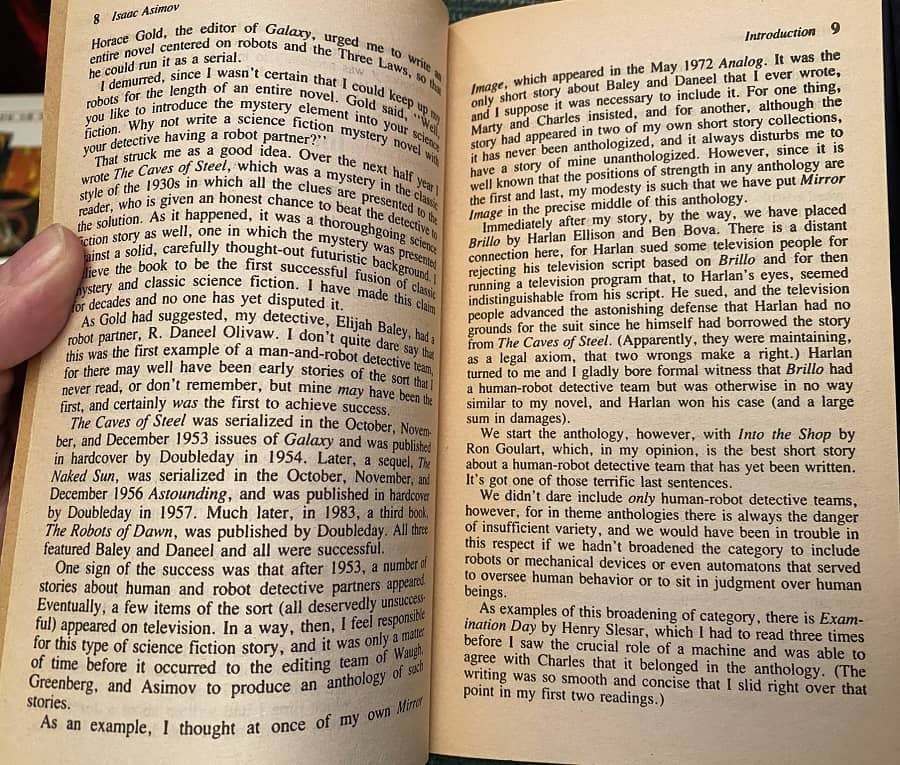
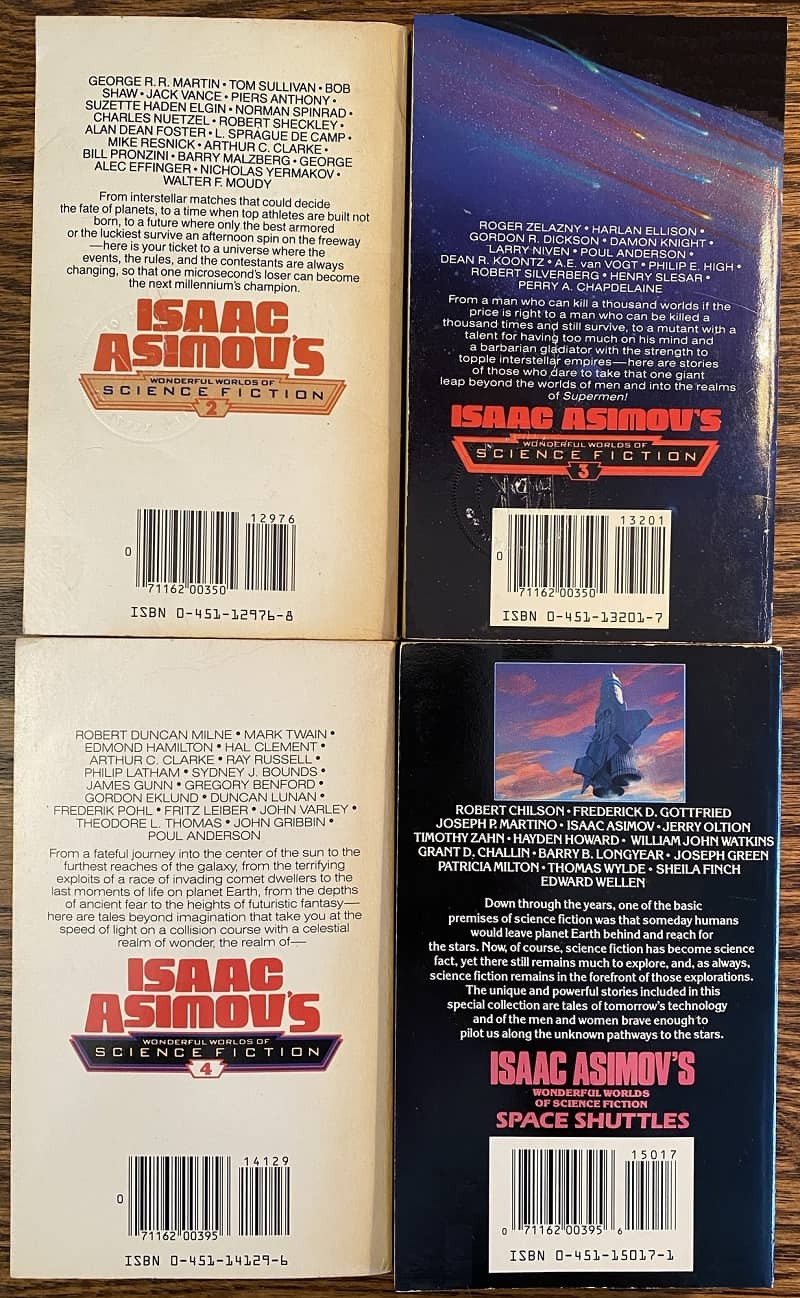
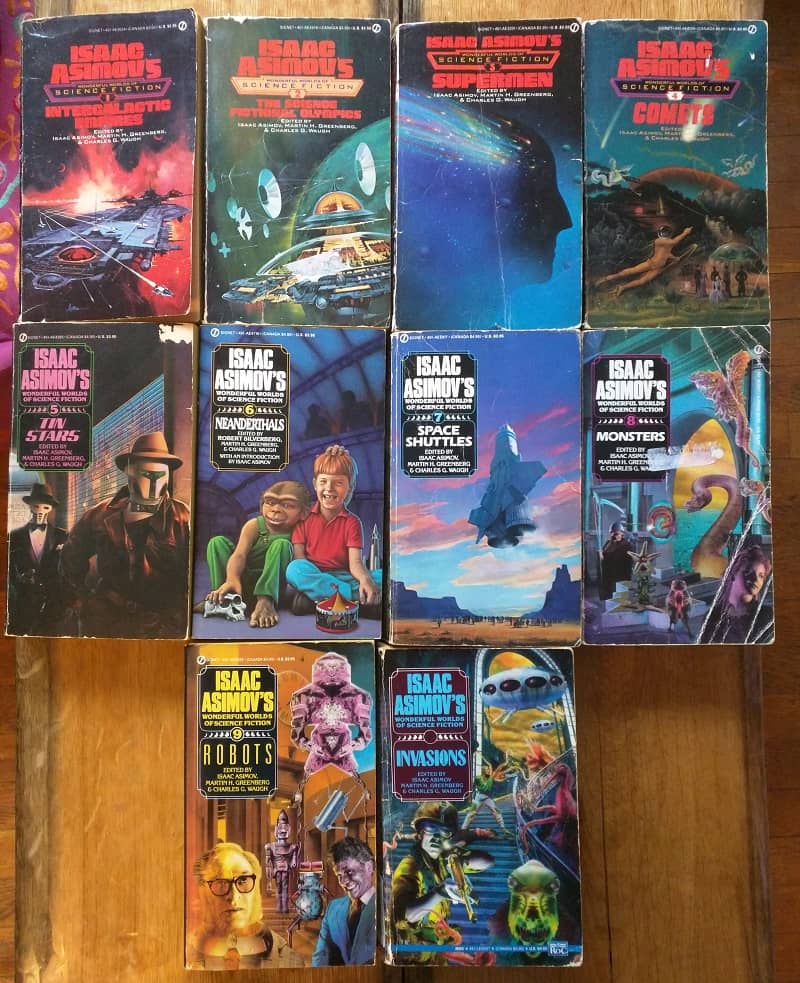
holy crap, that cover of the Tin Stars volume is exactly what i love, it evokes crime/hard boiled noir detectives with futuristic themes. i dont say sci fi themes becaue i do find a slight rift between what ssci fi is to me, and what just futuristic is, like blade runner movies, sure there is space travel and other worlds, but you never really hear or see about them, it’s all set only slightly in the future and most of the super advanced tech isnt even on earth anymore. i dunno maybe i have a weird perspective.
i need to find this copy, even if none of the stories match the cover, i want it! the sheer potential it says to me… hahaha thanks for the great article.
side note, the only Ron Goulart i have read is the whole Tek War series he did for Shatner, but i liked them as fun cheesy detective sci fi. i wonder if the story in this collection will be like those novels? i cant wait to see, i already ordered a copy. thanks again Mr. O’Neill!
Goulart’s mode in his “own” work was mostly humorous; his SF universe was a slapstick one. DAW published a ton of his novels; I’ve always found them enjoyable. Probably his most serious work was After Things Fell Apart, which was published as an Ace Special (with a great Dillon cover).
John: Yes, Dr. Asimov loved to write! I can’t resist remarking here upon his singular literary achievement (from WIKI): “Asimov was so prolific and diverse in his writing that his books span all major categories of the Dewey Decimal Classification except for category 100, philosophy and psychology.”
!!
Also: I will long remember and cherish Dr. Asimov’s response to the question as to
whether or not he read criticism of his books (close paraphrase): “Of course I do! And at the first hint of anything negative I stop reading.” Heh!
> holy crap, that cover of the Tin Stars volume is exactly what i love, it evokes crime/hard boiled noir detectives with futuristic themes.
Dante — I agree completely. It’s a fantastic cover, with two stylish robots dressed up like 30s gangsters and absolutely nailing the look. I love a good cross-genre SF mystery, but I admit the cover is what drew me to the book over the others.
The art is credited to JAV at ISFDB, which I assume are initials? Maybe hidden somewhere on the painting, though I haven’t spotted them.
There are no other SF covers attributed to JAV in the database, so her identity is something of a mystery.
> the only Ron Goulart i have read is the whole Tek War series he did for Shatner, but i liked them as fun cheesy detective sci fi.
Dante,
Ron Goulart’s story “What’s Become of Screwloose?” is a great bit of hard-boiled noir about an android tutor that they forget to switch off, and the long-term trouble it causes. Based just on that story, I totally believe Asimov’s assertion that Goulart wrote “the best short story about a human-robot detective team that has yet been written.”
Here’s my review of Screwloose:
https://www.blackgate.com/whats-become-of-screwloose-and-other-great-short-fiction-by-ron-goulart/
> i already ordered a copy. thanks again Mr. O’Neill!
Let me know what you think when it arrives!
The Intergalactic Empires one included the only Foundation story in which Asimov’s included an alien species (Blind Alley).
> Goulart’s mode in his “own” work was mostly humorous; his SF universe was a slapstick one.
Thomas,
Certainly the collection I read (What’s Become of Screwloose? And Other Inquiries) had a lot of very offbeat (and frequently on-target) humor. Quite unlike any other SF being published at the time — or since.
> Asimov was so prolific and diverse in his writing that his books span all major
> categories of the Dewey Decimal Classification except for category 100
Carl,
I was a huge Foundation and I, Robot fan in my youth, but these days when I read Asimov it usually tends to be his non-fiction, and especially his lively science columns, which were collected in many fine paperbacks.
Goulart could be quite funny. He’s the reason – along with Harry Harrison, Stanislaw Lem, and especially Robert Sheckley – that I didn’t fall back in a swoon when I read Douglas Adams; I’d seen it all before.
Is the one robot on the cover of number 5 the very inspiration for Boba Fett?! It’s even got the antenna/viewfinder!
Isaac and Marty were my mentors. Isaac seemed to know everything about everything. Marty was great with ideas (as am I), but also a terrific salesman (which I am not). Fortunately my reading tastes were close to Isaac’s, so very rarely did we disagree. I’ve always seen my books as my legacy, so I’ve tried to put everything I had into each one. Since I’ve had my nose in a book since about four, and have a good memory for stories, it helps. But I also do a lot of research (online these days), sometimes driving my publisher since 2012 (SamTeddy Publishing) nuts with last minute changes. But if you liked what I did then, you should check out what I’ve done in the last 9 years. Google my name, get on the SF site, and you’ll see most of the fantastic ones listed. (Due to the kind help of another.) By my birthday this summer, assuming I don’t croke beforehand, I will have published my 250th book. Hard to believe.
And thanks for the very kind comments. Charles
You like reprint anthologies. Email me and I’ll send you an electronic, pre-publication copy of The Rivals of H. G. Wells. It covers the years from 1886 to 1923, and is, in my humble opinion, the best anthology yet done on that period.
> if you liked what I did then, you should check out what I’ve done in the last 9 years.
> Google my name, get on the SF site, and you’ll see most of the fantastic ones listed.
Charles,
Thanks so much for the comment! I just checked out your listing at The Internet Science Fiction Database:
http://www.isfdb.org/cgi-bin/ea.cgi?7778
and Holy Cats! I see what you mean. That’s an enormous catalog of fabulous books.
I deeply appreciate your offer to get in touch regarding a pre-publication copy of The Rivals of H. G. Wells. I’ve sent you a private email.
Many thanks for this feature, and all your reviews! For what it’s worth, Asimov may have done somewhat more work on these anthologies than is indicated in this piece. He wrote an essay, “Anthologies” (in his collection Gold), in which he described in some detail the work he did with Greenberg and Waugh, which by his account included reading through and helping to select the stories, even though Greenberg may have done the greater part of the work in this regard.